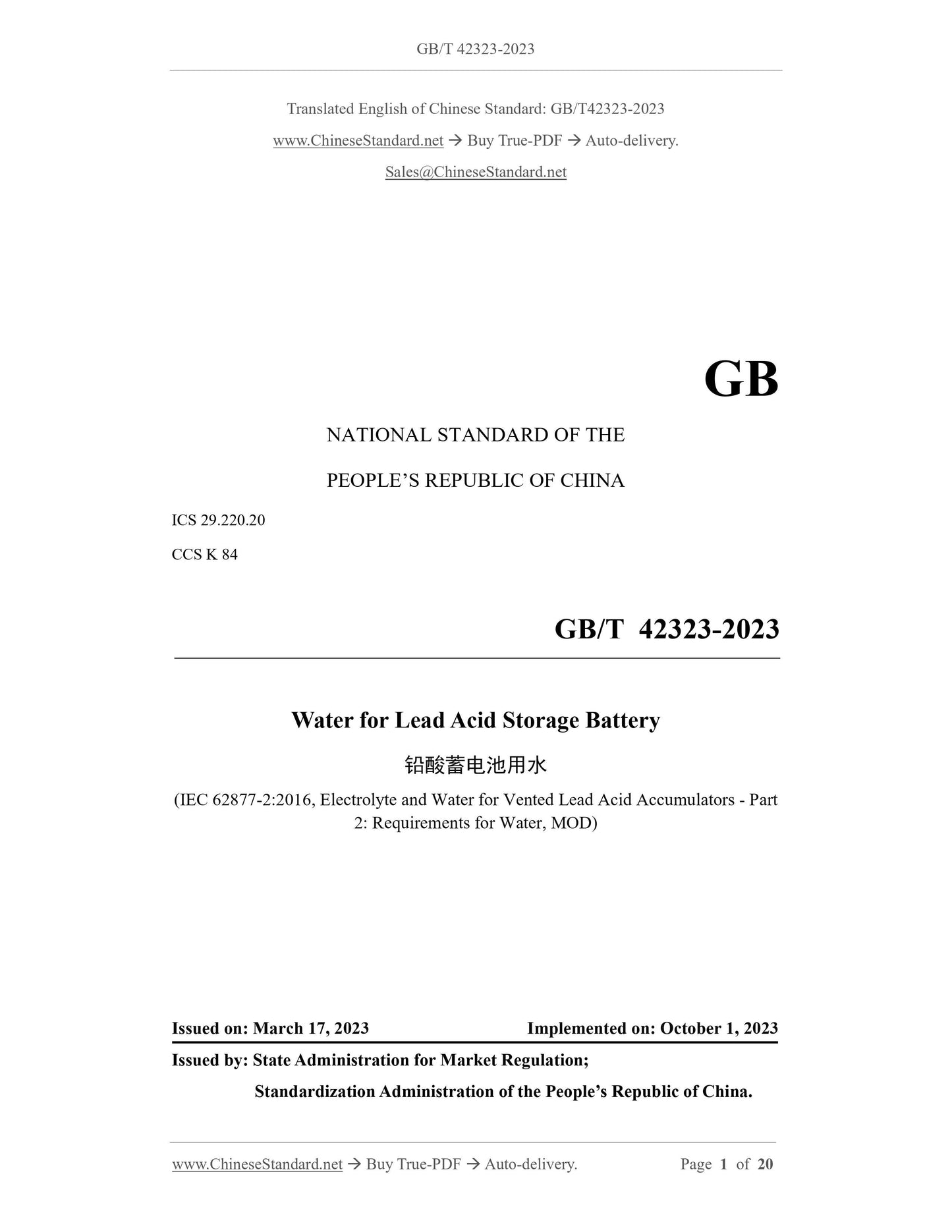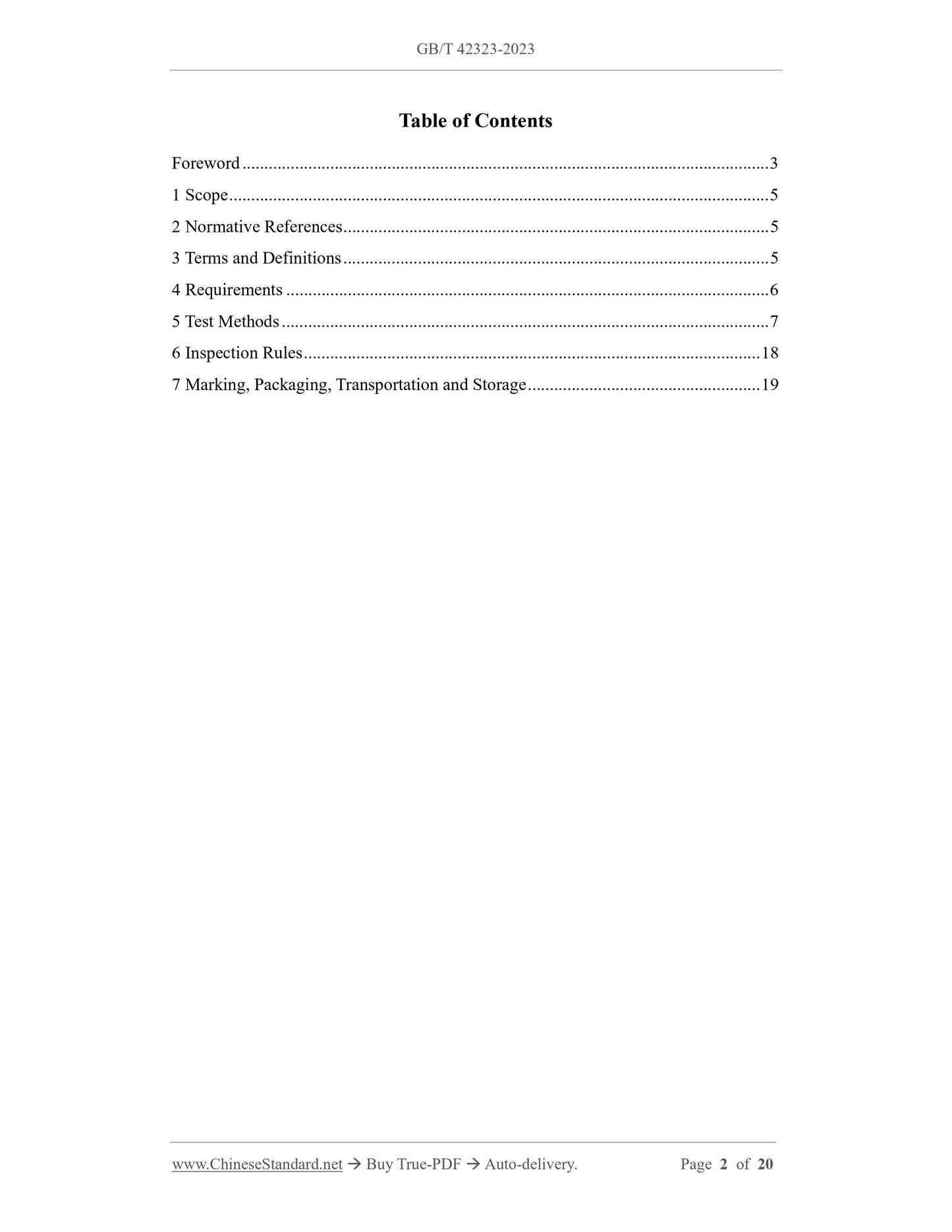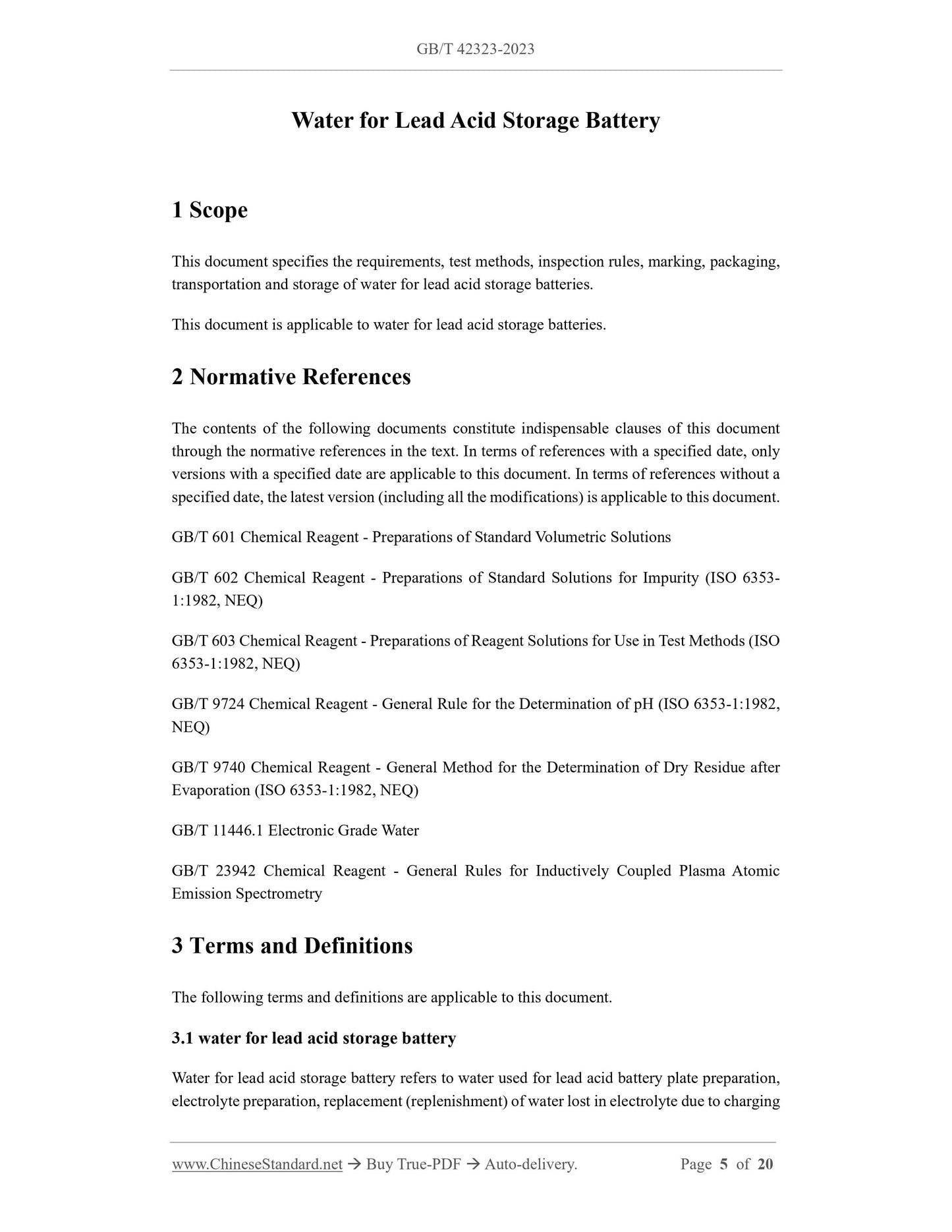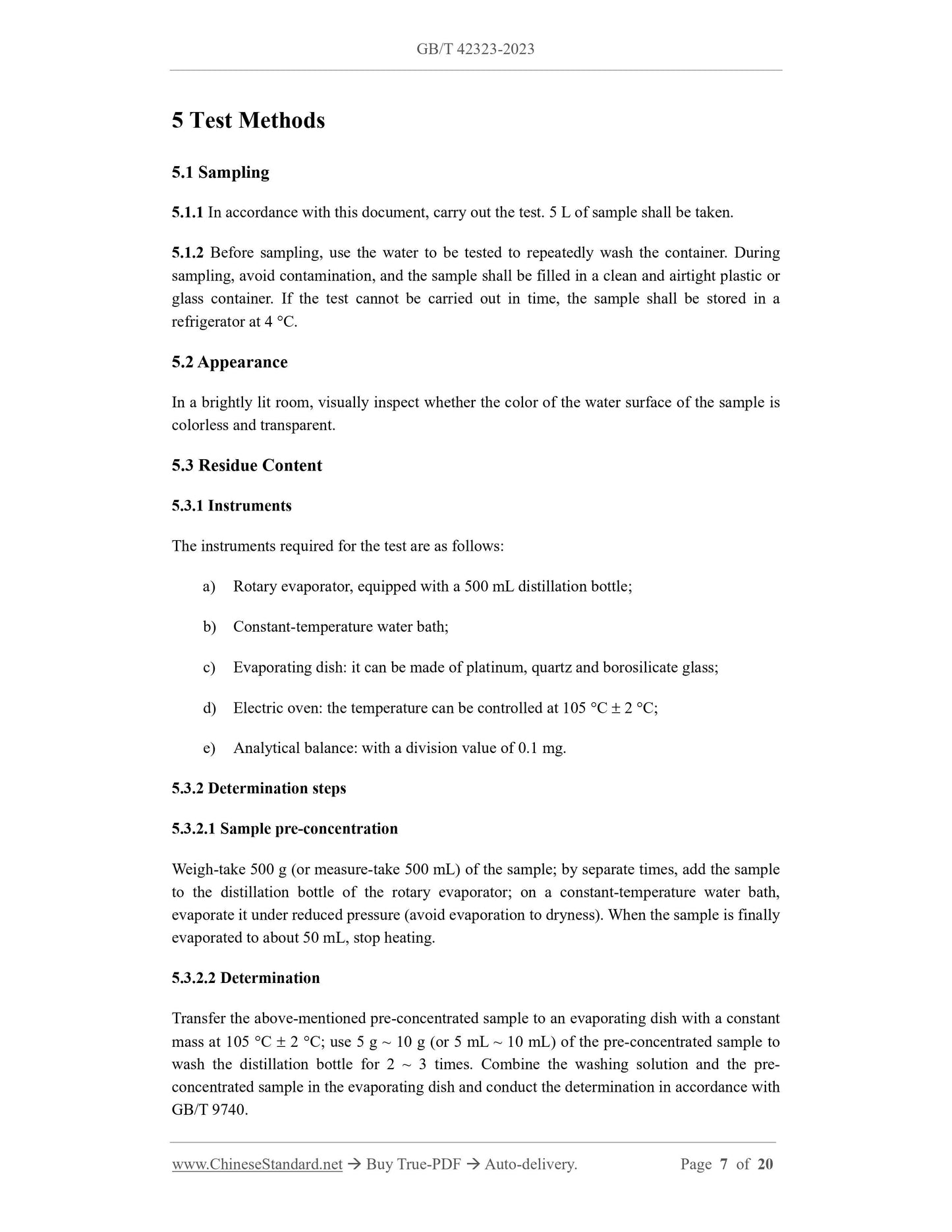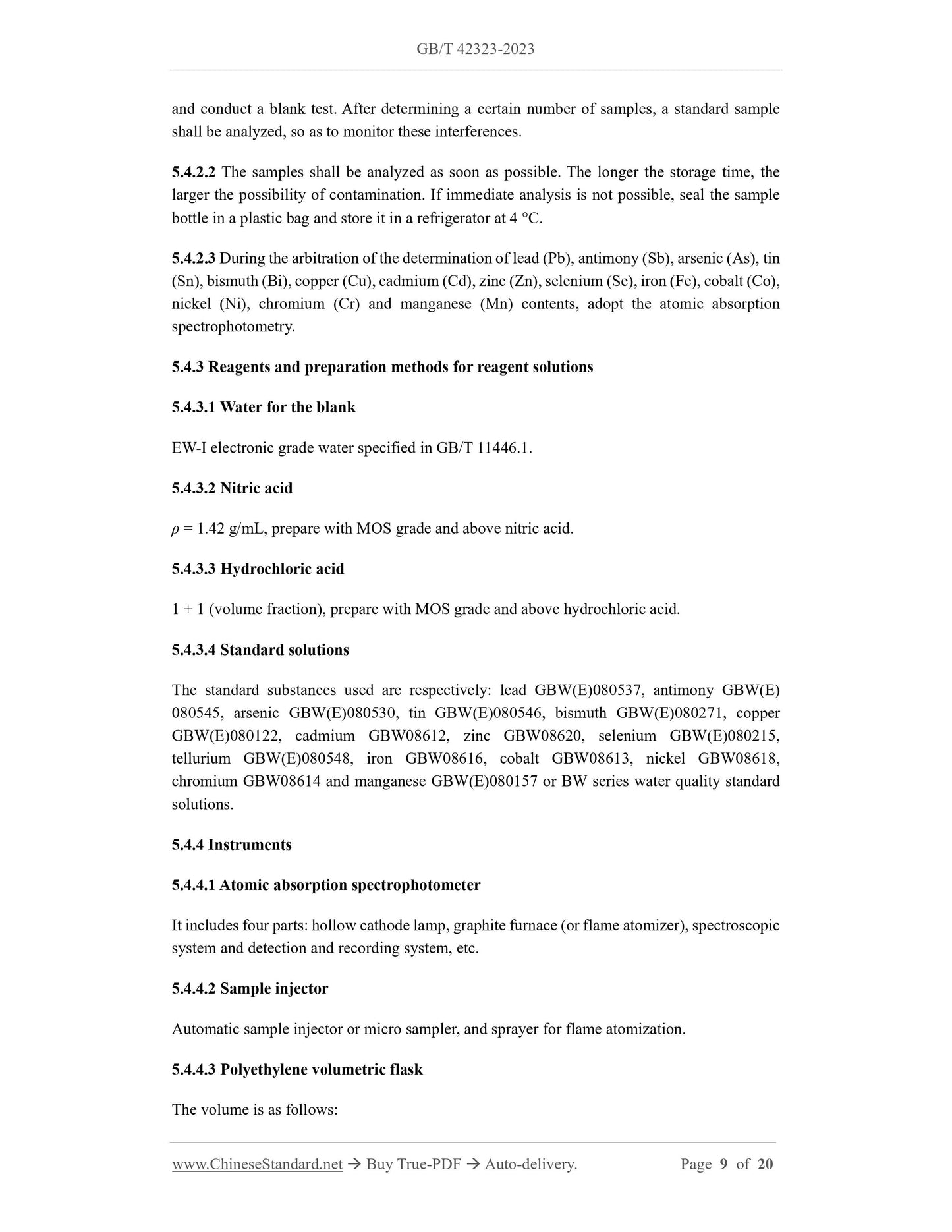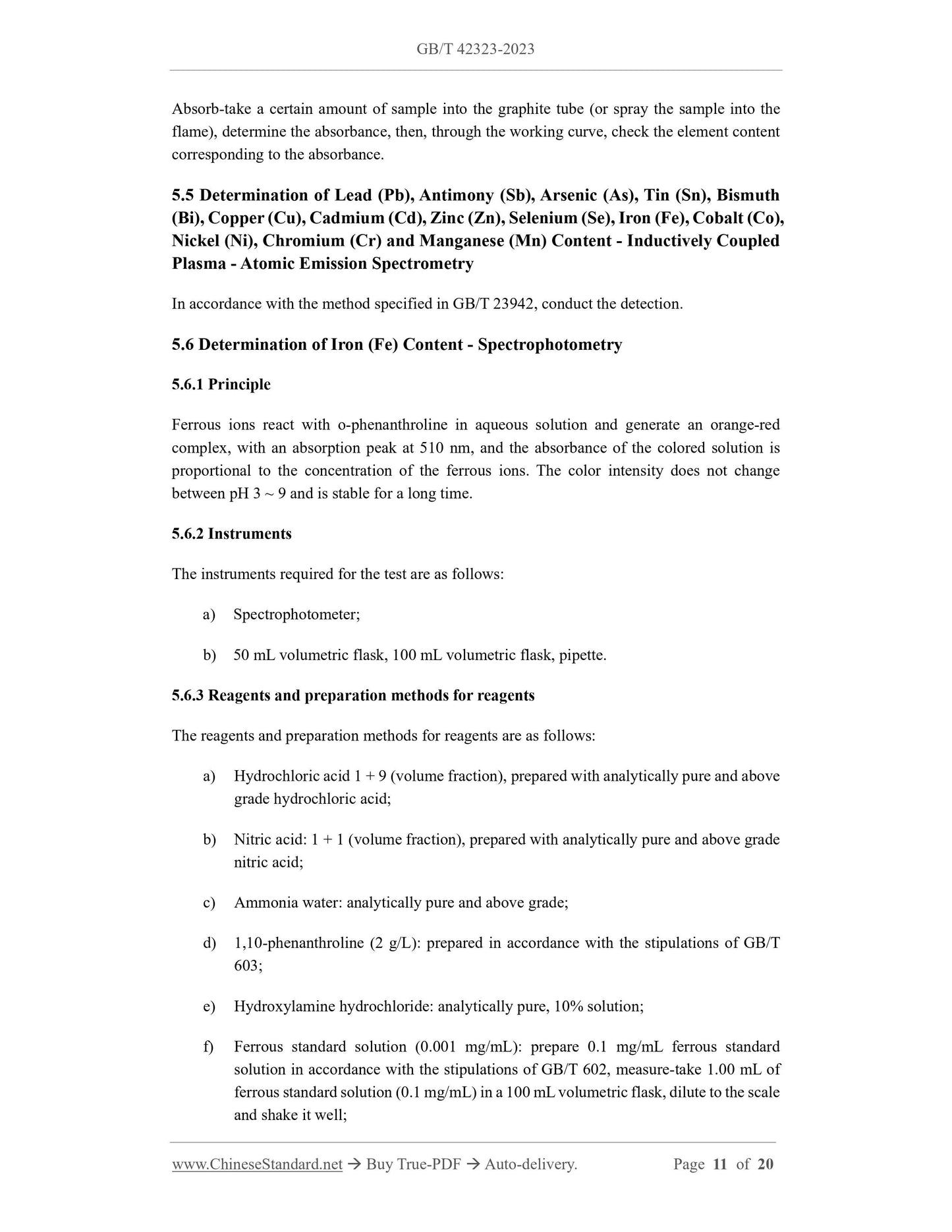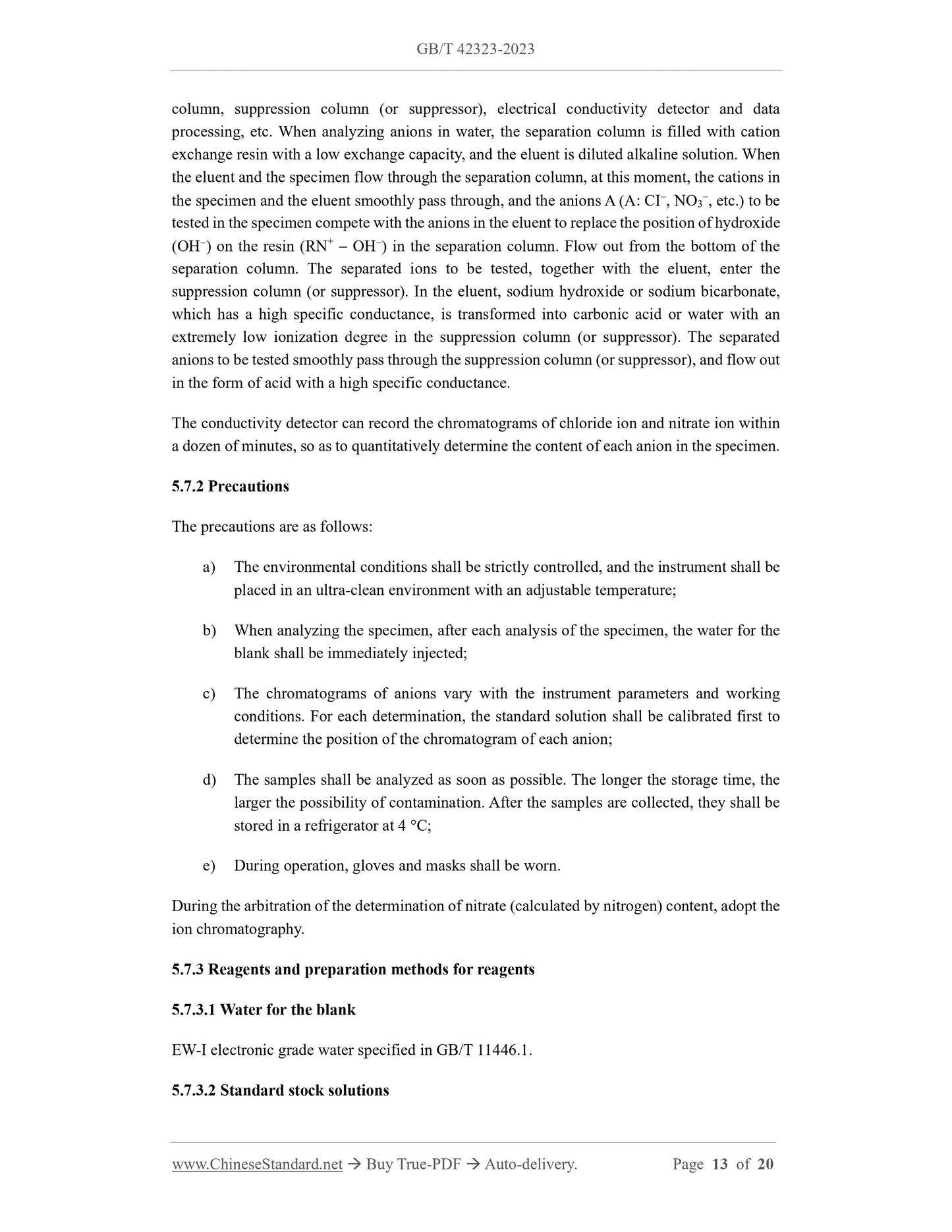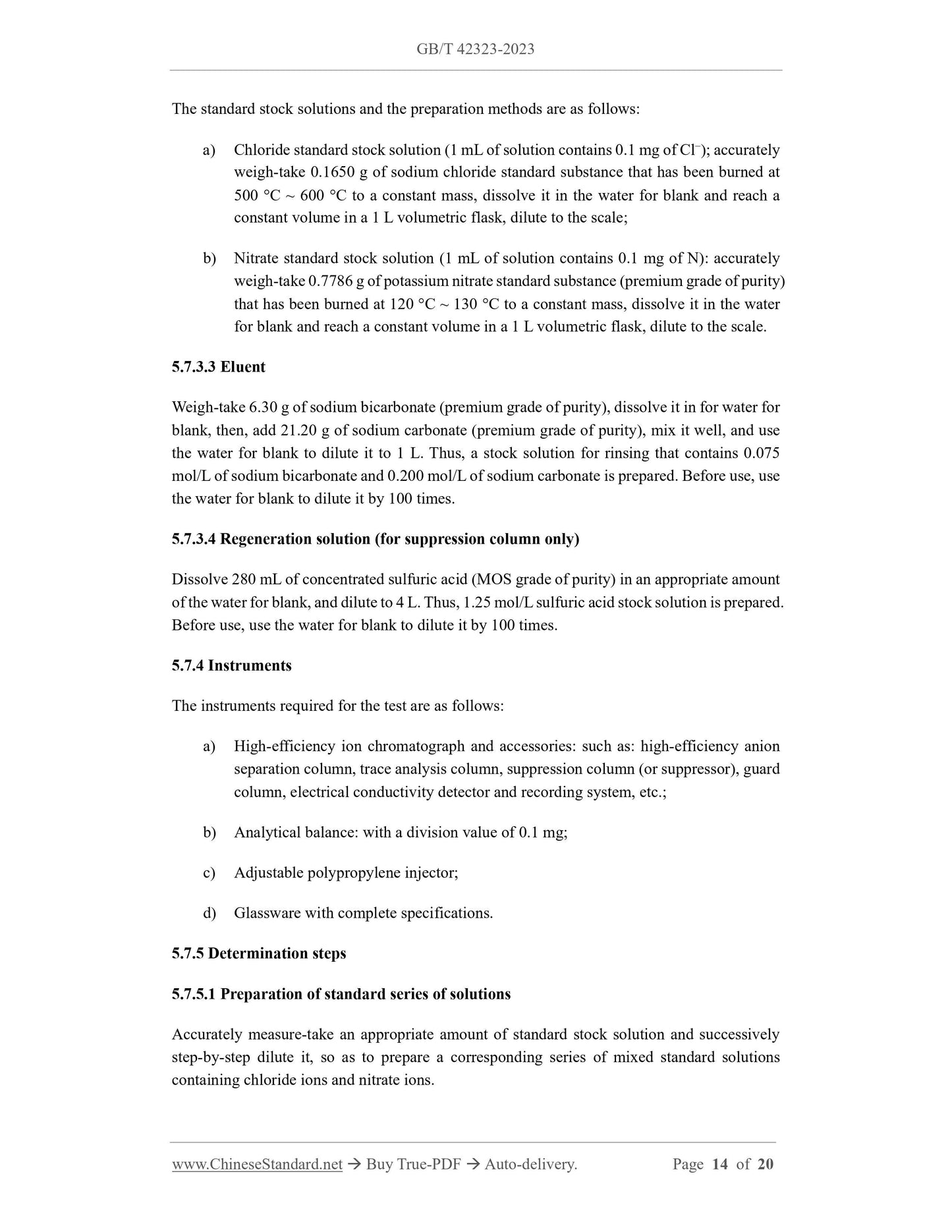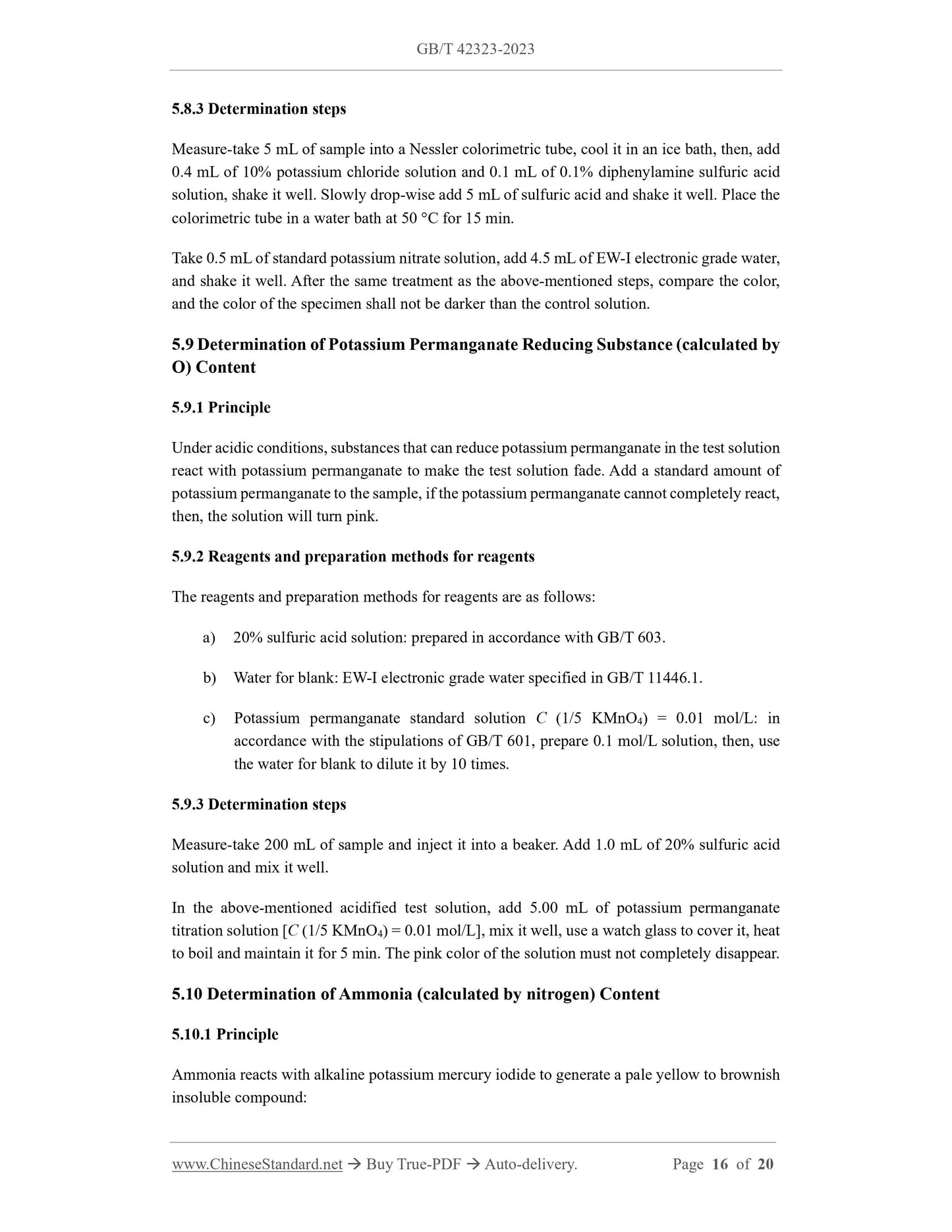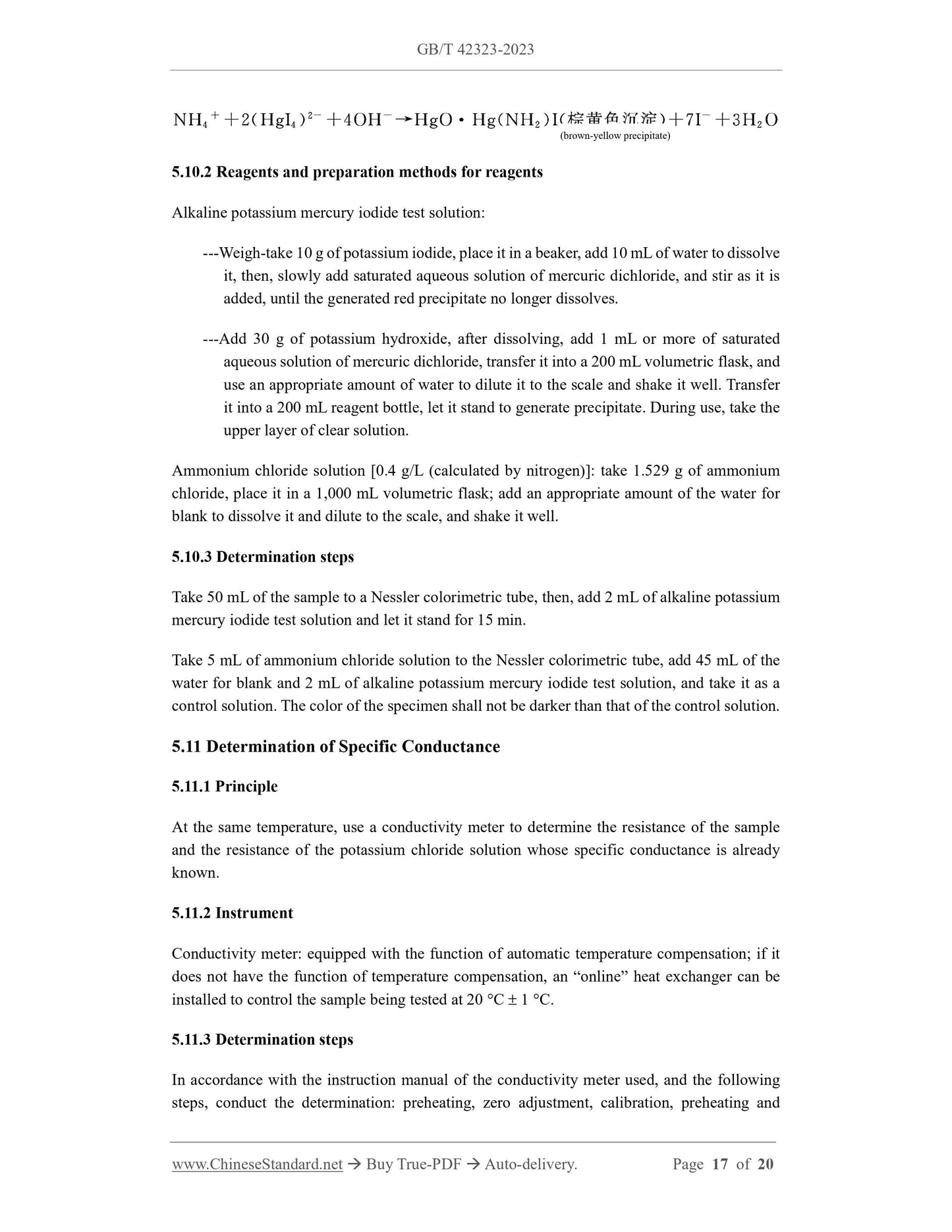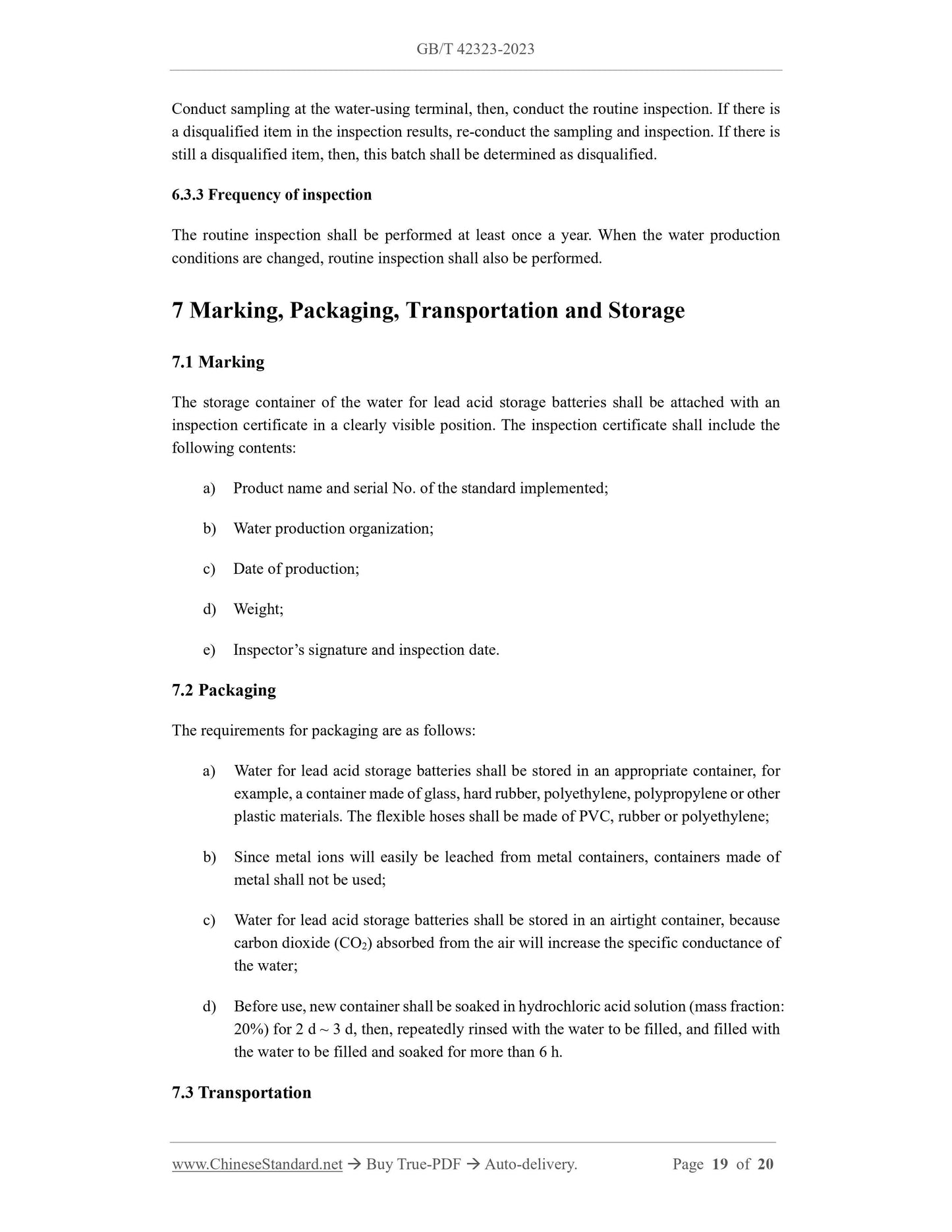1
/
of
11
PayPal, credit cards. Download editable-PDF & invoice in 1 second!
GB/T 42323-2023 English PDF (GBT42323-2023)
GB/T 42323-2023 English PDF (GBT42323-2023)
Regular price
$185.00 USD
Regular price
Sale price
$185.00 USD
Unit price
/
per
Shipping calculated at checkout.
Couldn't load pickup availability
Delivery: 3 seconds. Download true-PDF + Invoice.
Get QUOTATION in 1-minute: Click GB/T 42323-2023
Historical versions: GB/T 42323-2023
Preview True-PDF (Reload/Scroll if blank)
GB/T 42323-2023: Water for lead acid storage battery
GB/T 42323-2023
GB
NATIONAL STANDARD OF THE
PEOPLE’S REPUBLIC OF CHINA
ICS 29.220.20
CCS K 84
Water for Lead Acid Storage Battery
(IEC 62877-2:2016, Electrolyte and Water for Vented Lead Acid Accumulators - Part
2: Requirements for Water, MOD)
ISSUED ON: MARCH 17, 2023
IMPLEMENTED ON: OCTOBER 1, 2023
Issued by: State Administration for Market Regulation;
Standardization Administration of the People’s Republic of China.
Table of Contents
Foreword ... 3
1 Scope ... 5
2 Normative References ... 5
3 Terms and Definitions ... 5
4 Requirements ... 6
5 Test Methods ... 7
6 Inspection Rules ... 18
7 Marking, Packaging, Transportation and Storage ... 19
Water for Lead Acid Storage Battery
1 Scope
This document specifies the requirements, test methods, inspection rules, marking, packaging,
transportation and storage of water for lead acid storage batteries.
This document is applicable to water for lead acid storage batteries.
2 Normative References
The contents of the following documents constitute indispensable clauses of this document
through the normative references in the text. In terms of references with a specified date, only
versions with a specified date are applicable to this document. In terms of references without a
specified date, the latest version (including all the modifications) is applicable to this document.
GB/T 601 Chemical Reagent - Preparations of Standard Volumetric Solutions
GB/T 602 Chemical Reagent - Preparations of Standard Solutions for Impurity (ISO 6353-
1:1982, NEQ)
GB/T 603 Chemical Reagent - Preparations of Reagent Solutions for Use in Test Methods (ISO
6353-1:1982, NEQ)
GB/T 9724 Chemical Reagent - General Rule for the Determination of pH (ISO 6353-1:1982,
NEQ)
GB/T 9740 Chemical Reagent - General Method for the Determination of Dry Residue after
Evaporation (ISO 6353-1:1982, NEQ)
GB/T 11446.1 Electronic Grade Water
GB/T 23942 Chemical Reagent - General Rules for Inductively Coupled Plasma Atomic
Emission Spectrometry
3 Terms and Definitions
The following terms and definitions are applicable to this document.
3.1 water for lead acid storage battery
Water for lead acid storage battery refers to water used for lead acid battery plate preparation,
electrolyte preparation, replacement (replenishment) of water lost in electrolyte due to charging
5 Test Methods
5.1 Sampling
5.1.1 In accordance with this document, carry out the test. 5 L of sample shall be taken.
5.1.2 Before sampling, use the water to be tested to repeatedly wash the container. During
sampling, avoid contamination, and the sample shall be filled in a clean and airtight plastic or
glass container. If the test cannot be carried out in time, the sample shall be stored in a
refrigerator at 4 C.
5.2 Appearance
In a brightly lit room, visually inspect whether the color of the water surface of the sample is
colorless and transparent.
5.3 Residue Content
5.3.1 Instruments
The instruments required for the test are as follows:
a) Rotary evaporator, equipped with a 500 mL distillation bottle;
b) Constant-temperature water bath;
c) Evaporating dish: it can be made of platinum, quartz and borosilicate glass;
d) Electric oven: the temperature can be controlled at 105 C 2 C;
e) Analytical balance: with a division value of 0.1 mg.
5.3.2 Determination steps
5.3.2.1 Sample pre-concentration
Weigh-take 500 g (or measure-take 500 mL) of the sample; by separate times, add the sample
to the distillation bottle of the rotary evaporator; on a constant-temperature water bath,
evaporate it under reduced pressure (avoid evaporation to dryness). When the sample is finally
evaporated to about 50 mL, stop heating.
5.3.2.2 Determination
Transfer the above-mentioned pre-concentrated sample to an evaporating dish with a constant
mass at 105 C 2 C; use 5 g ~ 10 g (or 5 mL ~ 10 mL) of the pre-concentrated sample to
wash the distillation bottle for 2 ~ 3 times. Combine the washing solution and the pre-
concentrated sample in the evaporating dish and conduct the determination in accordance with
GB/T 9740.
and conduct a blank test. After determining a certain number of samples, a standard sample
shall be analyzed, so as to monitor these interferences.
5.4.2.2 The samples shall be analyzed as soon as possible. The longer the storage time, the
larger the possibility of contamination. If immediate analysis is not possible, seal the sample
bottle in a plastic bag and store it in a refrigerator at 4 C.
5.4.2.3 During the arbitration of the determination of lead (Pb), antimony (Sb), arsenic (As), tin
(Sn), bismuth (Bi), copper (Cu), cadmium (Cd), zinc (Zn), selenium (Se), iron (Fe), cobalt (Co),
nickel (Ni), chromium (Cr) and manganese (Mn) contents, adopt the atomic absorption
spectrophotometry.
5.4.3 Reagents and preparation methods for reagent solutions
5.4.3.1 Water for the blank
EW-I electronic grade water specified in GB/T 11446.1.
5.4.3.2 Nitric acid
ρ = 1.42 g/mL, prepare with MOS grade and above nitric acid.
5.4.3.3 Hydrochloric acid
1 + 1 (volume fraction), prepare with MOS grade and above hydrochloric acid.
5.4.3.4 Standard solutions
The standard substances used are respectively: lead GBW(E)080537, antimony GBW(E)
080545, arsenic GBW(E)080530, tin GBW(E)080546, bismuth GBW(E)080271, copper
GBW(E)080122, cadmium GBW08612, zinc GBW08620, selenium GBW(E)080215,
tellurium GBW(E)080548, iron GBW08616, cobalt GBW08613, nickel GBW08618,
chromium GBW08614 and manganese GBW(E)080157 or BW series water quality standard
solutions.
5.4.4 Instruments
5.4.4.1 Atomic absorption spectrophotometer
It includes four parts: hollow cathode lamp, graphite furnace (or flame atomizer), spectroscopic
system and detection and recording system, etc.
5.4.4.2 Sample injector
Automatic sample injector or micro sampler, and sprayer for flame atomization.
5.4.4.3 Polyethylene volumetric flask
The volume is as follows:
Absorb-take a certain amount of sample into the graphite tube (or spray the sample into the
flame), determine the absorbance, then, through the working curve, check the element content
corresponding to the absorbance.
5.5 Determination of Lead (Pb), Antimony (Sb), Arsenic (As), Tin (Sn), Bismuth
(Bi), Copper (Cu), Cadmium (Cd), Zinc (Zn), Selenium (Se), Iron (Fe), Cobalt (Co),
Nickel (Ni), Chromium (Cr) and Manganese (Mn) Content - Inductively Coupled
Plasma - Atomic Emission Spectrometry
In accordance with the method specified in GB/T 23942, conduct the detection.
5.6 Determination of Iron (Fe) Content - Spectrophotometry
5.6.1 Principle
Ferrous ions react with o-phenanthroline in aqueous solution and generate an orange-red
complex, with an absorption peak at 510 nm, and the absorbance of the colored solution is
proportional to the concentration of the ferrous ions. The color intensity does not change
between pH 3 ~ 9 and is stable for a long time.
5.6.2 Instruments
The instruments required for the test are as follows:
a) Spectrophotometer;
b) 50 mL volumetric flask, 100 mL volumetric flask, pipette.
5.6.3 Reagents and preparation methods for reagents
The reagents and preparation methods for reagents are as follows:
a) Hydrochloric acid 1 + 9 (volume fraction), prepared with analytically pure and above
grade hydrochloric acid;
b) Nitric acid: 1 + 1 (volume fraction), prepared with analytically pure and above grade
nitric acid;
c) Ammonia water: a...
Get QUOTATION in 1-minute: Click GB/T 42323-2023
Historical versions: GB/T 42323-2023
Preview True-PDF (Reload/Scroll if blank)
GB/T 42323-2023: Water for lead acid storage battery
GB/T 42323-2023
GB
NATIONAL STANDARD OF THE
PEOPLE’S REPUBLIC OF CHINA
ICS 29.220.20
CCS K 84
Water for Lead Acid Storage Battery
(IEC 62877-2:2016, Electrolyte and Water for Vented Lead Acid Accumulators - Part
2: Requirements for Water, MOD)
ISSUED ON: MARCH 17, 2023
IMPLEMENTED ON: OCTOBER 1, 2023
Issued by: State Administration for Market Regulation;
Standardization Administration of the People’s Republic of China.
Table of Contents
Foreword ... 3
1 Scope ... 5
2 Normative References ... 5
3 Terms and Definitions ... 5
4 Requirements ... 6
5 Test Methods ... 7
6 Inspection Rules ... 18
7 Marking, Packaging, Transportation and Storage ... 19
Water for Lead Acid Storage Battery
1 Scope
This document specifies the requirements, test methods, inspection rules, marking, packaging,
transportation and storage of water for lead acid storage batteries.
This document is applicable to water for lead acid storage batteries.
2 Normative References
The contents of the following documents constitute indispensable clauses of this document
through the normative references in the text. In terms of references with a specified date, only
versions with a specified date are applicable to this document. In terms of references without a
specified date, the latest version (including all the modifications) is applicable to this document.
GB/T 601 Chemical Reagent - Preparations of Standard Volumetric Solutions
GB/T 602 Chemical Reagent - Preparations of Standard Solutions for Impurity (ISO 6353-
1:1982, NEQ)
GB/T 603 Chemical Reagent - Preparations of Reagent Solutions for Use in Test Methods (ISO
6353-1:1982, NEQ)
GB/T 9724 Chemical Reagent - General Rule for the Determination of pH (ISO 6353-1:1982,
NEQ)
GB/T 9740 Chemical Reagent - General Method for the Determination of Dry Residue after
Evaporation (ISO 6353-1:1982, NEQ)
GB/T 11446.1 Electronic Grade Water
GB/T 23942 Chemical Reagent - General Rules for Inductively Coupled Plasma Atomic
Emission Spectrometry
3 Terms and Definitions
The following terms and definitions are applicable to this document.
3.1 water for lead acid storage battery
Water for lead acid storage battery refers to water used for lead acid battery plate preparation,
electrolyte preparation, replacement (replenishment) of water lost in electrolyte due to charging
5 Test Methods
5.1 Sampling
5.1.1 In accordance with this document, carry out the test. 5 L of sample shall be taken.
5.1.2 Before sampling, use the water to be tested to repeatedly wash the container. During
sampling, avoid contamination, and the sample shall be filled in a clean and airtight plastic or
glass container. If the test cannot be carried out in time, the sample shall be stored in a
refrigerator at 4 C.
5.2 Appearance
In a brightly lit room, visually inspect whether the color of the water surface of the sample is
colorless and transparent.
5.3 Residue Content
5.3.1 Instruments
The instruments required for the test are as follows:
a) Rotary evaporator, equipped with a 500 mL distillation bottle;
b) Constant-temperature water bath;
c) Evaporating dish: it can be made of platinum, quartz and borosilicate glass;
d) Electric oven: the temperature can be controlled at 105 C 2 C;
e) Analytical balance: with a division value of 0.1 mg.
5.3.2 Determination steps
5.3.2.1 Sample pre-concentration
Weigh-take 500 g (or measure-take 500 mL) of the sample; by separate times, add the sample
to the distillation bottle of the rotary evaporator; on a constant-temperature water bath,
evaporate it under reduced pressure (avoid evaporation to dryness). When the sample is finally
evaporated to about 50 mL, stop heating.
5.3.2.2 Determination
Transfer the above-mentioned pre-concentrated sample to an evaporating dish with a constant
mass at 105 C 2 C; use 5 g ~ 10 g (or 5 mL ~ 10 mL) of the pre-concentrated sample to
wash the distillation bottle for 2 ~ 3 times. Combine the washing solution and the pre-
concentrated sample in the evaporating dish and conduct the determination in accordance with
GB/T 9740.
and conduct a blank test. After determining a certain number of samples, a standard sample
shall be analyzed, so as to monitor these interferences.
5.4.2.2 The samples shall be analyzed as soon as possible. The longer the storage time, the
larger the possibility of contamination. If immediate analysis is not possible, seal the sample
bottle in a plastic bag and store it in a refrigerator at 4 C.
5.4.2.3 During the arbitration of the determination of lead (Pb), antimony (Sb), arsenic (As), tin
(Sn), bismuth (Bi), copper (Cu), cadmium (Cd), zinc (Zn), selenium (Se), iron (Fe), cobalt (Co),
nickel (Ni), chromium (Cr) and manganese (Mn) contents, adopt the atomic absorption
spectrophotometry.
5.4.3 Reagents and preparation methods for reagent solutions
5.4.3.1 Water for the blank
EW-I electronic grade water specified in GB/T 11446.1.
5.4.3.2 Nitric acid
ρ = 1.42 g/mL, prepare with MOS grade and above nitric acid.
5.4.3.3 Hydrochloric acid
1 + 1 (volume fraction), prepare with MOS grade and above hydrochloric acid.
5.4.3.4 Standard solutions
The standard substances used are respectively: lead GBW(E)080537, antimony GBW(E)
080545, arsenic GBW(E)080530, tin GBW(E)080546, bismuth GBW(E)080271, copper
GBW(E)080122, cadmium GBW08612, zinc GBW08620, selenium GBW(E)080215,
tellurium GBW(E)080548, iron GBW08616, cobalt GBW08613, nickel GBW08618,
chromium GBW08614 and manganese GBW(E)080157 or BW series water quality standard
solutions.
5.4.4 Instruments
5.4.4.1 Atomic absorption spectrophotometer
It includes four parts: hollow cathode lamp, graphite furnace (or flame atomizer), spectroscopic
system and detection and recording system, etc.
5.4.4.2 Sample injector
Automatic sample injector or micro sampler, and sprayer for flame atomization.
5.4.4.3 Polyethylene volumetric flask
The volume is as follows:
Absorb-take a certain amount of sample into the graphite tube (or spray the sample into the
flame), determine the absorbance, then, through the working curve, check the element content
corresponding to the absorbance.
5.5 Determination of Lead (Pb), Antimony (Sb), Arsenic (As), Tin (Sn), Bismuth
(Bi), Copper (Cu), Cadmium (Cd), Zinc (Zn), Selenium (Se), Iron (Fe), Cobalt (Co),
Nickel (Ni), Chromium (Cr) and Manganese (Mn) Content - Inductively Coupled
Plasma - Atomic Emission Spectrometry
In accordance with the method specified in GB/T 23942, conduct the detection.
5.6 Determination of Iron (Fe) Content - Spectrophotometry
5.6.1 Principle
Ferrous ions react with o-phenanthroline in aqueous solution and generate an orange-red
complex, with an absorption peak at 510 nm, and the absorbance of the colored solution is
proportional to the concentration of the ferrous ions. The color intensity does not change
between pH 3 ~ 9 and is stable for a long time.
5.6.2 Instruments
The instruments required for the test are as follows:
a) Spectrophotometer;
b) 50 mL volumetric flask, 100 mL volumetric flask, pipette.
5.6.3 Reagents and preparation methods for reagents
The reagents and preparation methods for reagents are as follows:
a) Hydrochloric acid 1 + 9 (volume fraction), prepared with analytically pure and above
grade hydrochloric acid;
b) Nitric acid: 1 + 1 (volume fraction), prepared with analytically pure and above grade
nitric acid;
c) Ammonia water: a...
Share
